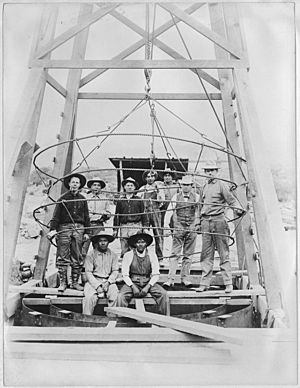Pala Indian Reservation facts for kids

Flag of the Pala Band of Cupeño Indians
|
|

Pala Reservation. Reinforcement of first joint of caisson - NARA
|
|
| Total population | |
|---|---|
| 1,573 reservation population (2000 US Census) | |
| Regions with significant populations | |
| United States (California) | |
| Languages | |
| English, Luiseño, Cupeño | |
| Related ethnic groups | |
| other Cupeño people, Luiseño people |
The Pala Indian Reservation is a special place located in the middle of the San Luis Rey River Valley. You can find it in northern San Diego County, California, just east of a town called Fallbrook.
This area has been known by other names in the past, like "Mission Indian Reservation." Today, the people who live here are part of a federally recognized tribe called the Pala Band of Mission Indians. They are descendants of both the Cupeño and Luiseño peoples, who have lived together on this land since 1903. The Pala Reservation is the most populated Native American reservation in San Diego County.
The reservation covers about 52 square kilometers (20 square miles). In the year 2000, 1,573 people lived there. About 44 percent of these residents were of Native American heritage. The leader of the tribe is called the Tribal Chairman, and his name is Robert H. Smith.
Contents
Life on the Pala Reservation
The Pala Indian Reservation is located in and around the community of Pala, California. The tribal members living here come from two main Native American groups: a band of the Luiseño tribe and the Cupeño Indians. The Cupeño were historically one of the smallest tribes in California, and they called themselves Kuupangaxwichem.
The reservation is also home to its own radio station, Pala Rez Radio KPRI 91.3 FM. This station helps keep the community connected and shares important information.
A Look Back: History of the Pala People
Long ago, during the time when Spain had missions in California, Pala was the site of San Antonio de Pala Asistencia. This was like a branch or "arm" of the main Catholic Mission San Luis Rey de Francia, which was located closer to the coast. The old grounds of this asistencia still have a historic cemetery.
The Pala tribe is officially recognized by the United States government. A sad part of their history happened in 1901. The Cupeño people were forced to leave their ancestral homeland, which they called Kupa. This land is now known as Warner's Ranch, located east of Pala. The tribe remembers this event as the "Cupeño Trail of Tears."
In May 1903, the Cupeño were moved to a piece of land in the Pala Valley. This land was next to the Pala Luiseño reservation that already existed. The government bought this land specifically for them. However, the new land had no buildings or facilities, so the Cupeño had to sleep outdoors. They also lost their spiritual connection to their old land, which was very important to their Chinigchinich religion. They have not been able to get their original homeland, Kupa, back.
How the Pala Tribe Supports Itself
The Pala Band has traditionally been a modest tribe. However, since the late 1900s, they have built a very successful casino and resort hotel called Pala Casino Resort and Spa. This business has helped the tribe a lot.
The money earned from the casino and hotel is used to help the tribal members. It funds social services, education, and improvements to the reservation's buildings and roads. The Pala tribe also has a 90-acre avocado farm on the southern part of the reservation. This farm provides jobs for over 40 people.
Here are some ways the gaming profits have helped the community:
- A $1.5 million program to help members get home loans.
- A $300,000 scholarship fund to help young people go to college.
- More land for the tribal cemetery.
- Firefighter and paramedic services for the community.
- A 24-hour ambulance service.
- The 24/7 non-commercial FM radio station, KPRI, known as "Rez Radio 91.3."
Caring for the Environment
The Pala Reservation has its own Environmental Department. This department works to keep the air, water, and land clean and healthy on the reservation. In 1999, the U.S. government gave the reservation a grant. This money helped the tribe buy technology, train staff, and get other things needed to run the department.
Some of the important tasks this department does include:
- Calculating the air quality index for the area. This tells people about pollutants in the air and suggests ways to fix them.
- Making sure the water meets Federal Safe Drinking Water Act standards. They also work on saving water on the reservation.
- Protecting and taking care of historical and cultural sites.
Other Luiseño Communities
There are other federally recognized tribes of related people in Southern California. For example, the Pauma Band of Luiseno Mission Indians lives to the southeast, near State Route 76. In total, there are five other federally recognized Luiseño tribes in Southern California.


